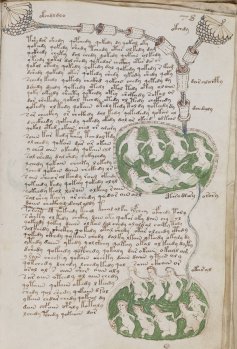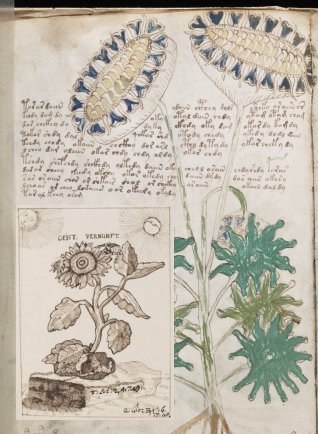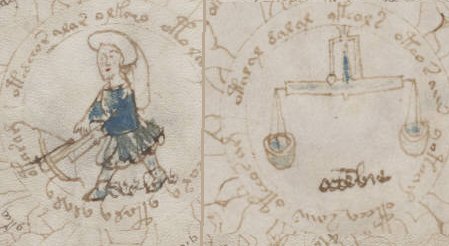It is nearly 100 years since the Voynich manuscript arrived in America. In that time, not one person or group has managed to decode even a single word of it.
I suggest that decryption of any document requires as much prior knowledge as possible about the physical document, its origin and purpose. For that reason, I am compiling a background to the Voynich manuscript before any discussion of possible encryption schemes.
The Voynich manuscript is named after the man who first showed it in America, the book dealer Wilfrid Voynich. Much less is known about him than about his wife, Ethel. In Part #1 of this series, I focused on a brief biography of Wilfrid and Ethel Voynich. The story continues with an overview of various theories about the age, origin and purpose of the Voynich manuscript.
But remember, you’re not trying to prove your theory is correct here (for what kind of an idiot would attempt that with such scanty evidence, 500-ish years after the event?) Rather, you’re just staking your claim to the possibility that [random person X] might have been the author. And the level of proof required to achieve that is, frankly, negligible.
And hey, even if you choose the name with a pin and a biographical dictionary, if it eventually turns out that you are right, think how unbearably smug you’ll be. Possibly for decades!
Nick Pelling, Become A Voynich Manuscript Expert In Just 5 Minutes
The Enigmatic Voynich Manuscript.
The Voynich Manuscript is in the Beinecke Rare Book And Manuscript Library of Yale University, listed as Beineke MS 408. It is a handwritten parchment codex of about 240 pages measuring 225 x 160 mm. The manuscript is in an unreadable script. Most of its pages are illustrated.

MS 408, Folio 78, recto.
The first public notification of the existence of the manuscript was in a catalogue of the Art Institute of Chicago for an exhibition of Oct.7 - Nov.3, 1915. Wilfrid Voynich stated that he purchased the manuscript, with others, in 1912 from Jesuits in the Villa Mondragone in Italy. A question arises immediately as to why a religious order would sell valuable manuscripts to a foreign book dealer.
As mentioned in Part #1 , many of the the Voyniches' friends and associates were involved in political intrigue and knew many famous revolutionaries of the era. Ethel and Wilfred Voynich knew Sidney Reilly, and Wilfrid had a friend in the Catholic Church who later became Pope1. Could they have been (highly) paid by some political agency to engage in secret activity? Italy, even after unification in 1861, remained a land in turmoil. The Jesuits, faced with seizure by the state of their assets had assigned some of them them as 'private property' to faculty members. Some of the manuscripts sold by the Villa Mondragone were purchased by Pope Pius X.
Fake, Forgery Or Not?
In part 1, I suggested that Wilfrid Voynich had no financial incentive to manufacture MS 408. There have been suggestions of skulduggery, but of all the manuscripts sold by Voynich, as far as I can discover, it is only in the case of MS 408 that there is any suggestion of forgery. It may well be that he had a degree in chemistry2, and had studied books on fake inks at the British Museum library. But it may well be that as a prudent buyer of rare manuscripts, he was studying methods of faking so as not to be the victim of fraud.
Since MS 408 was first shown in America, nearly 100 years ago, it has been examined directly, or via photocopies or web images by many enthusiastic would-be codebreakers, expert and amateur. A few books have been published. At least one TV documentary has been produced. But there has never been an acceptable demonstration that it may have been fabricated by Voynich and there is, as yet, no definite date for the creation of MS 408. It is somewhat incredible that until this year, no truly scientific testing has been attempted to establish chemistry and dates for the parchment, ink and colorants.
In The New Journal, Vol 41, #4, Feb 2009, Yale Library anounced that scientific tests were being conducted.
... it caught the eye of some documentary producers interested in making a film about it. Scrambling to update and expand the document’s profile, the Beinecke librarians brought it to Sterling Memorial Library’s conservation laboratory. Here, two outside specialists are analyzing the pigments in its ink and carbon dating a tiny sample of its vellum.The New Journal
Might those documentary producers be the same ones who intend to release a Voynich Documentary in 2010? Perhaps these people will sit on the test results until the documentary is released. After all there's a lot of money to be made out of movie advertising hype.
Until the results of those tests are made public, we can only rely on guesses as to authenticity, of which there are very many: educated, somewhat less educated and, to put it kindly, undereducated.
Dating The Voynich Manuscript
If MS 408 is bogus, a hoax, a complete fabrication, then the range of dates for that fabrication is from roughly 1550 to 1650 according to most theories. In order to endorse or challenge that date range, in the absence of forensic testing, we must examine every available clue.
The most important clue, I suggest, is the set drawings contained in the manuscript. Firstly, the bulk of these drawings are of plants. The flow of the text around these strongly suggests that the text was added after the drawings were done. I call them drawing because, although colored, it appears to me that the color was not added by the original illustrator. I am no art critic, but it seems that the colorants were applied with less care than the ink of the drawings and the text.
The drawings are very basic. I suggest that their inaccuracy stems from being drawn by an unskilled hand from memory or from written descriptions. If taken as representative sketches of plants drawn from memory or description it should be no surprise that the plants are difficult to identify when compared to real specimens, photographs or good quality illustrations.
There have been plant identifications both good and bad. There is a suggestion, apparently originating with Hugh O'Neill that f33v shows a sunflower. This has been taken to indicate an earliest date for the manuscript, the date when the sunflower was first introduced to Europe. Apart from Jorge Stolfi's analysis, a comparison between the Voynich "sunflower" and one depicted in a book of alchemy demonstrates that the VM flower is not a sunflower. (I feel that a comparison between sketches is more valid than between sketch and photo.)

MS 408, Folio 33, verso,
overlaid with an image from an Alchemical and Rosicrucian Compendium, Beinecke Rare Book and Manuscript Library, Yale.
There are some details about the manuscript that strongly suggest that it was not fabricated for gain, and which strongly suggest a date close to the year 1300.
The Devil Is In The Details
The manuscript is of generally low quality. The illustrations have a child-like style, with color somewhat carelessly applied. The parchment has more defects than a forger might presumably fake. Altogether, the overall appearance is one of a quality that would not inspire a significantly high price from an average manuscript collector.
There are three elements in MS 408 suggestive to me of a date around 1350. There are two small illustrations, one of Sagittarius, the archer, and one of Libra, the scales.

The crossbow picture has been examined by an expert, Jens Sensfelder:
... I would date the crossbow as drawn in the illustration to the first half of the 14th Century.The scales are of a type used in the 14th and 15th centuries. The balance beam is pivoted at the bottom of a stirrup. A vertical pointer helps to show more accurately when the bowls are in balance. The item is hand-held, for the weighing of small amounts of light goods.

Tacuinum Sanitatis, detail, source: Medieval pan balances
The third element suggestive of a date around 1350 is the section of the manuscript containing sketches of nude females. The hair and hairnet styles are all suggestive of this dating. The 'nudes' section is supposed by some to be an anatomical treatise. I suggest that it is a section on midwifery.
For much of European history up until about 1400 - 1450 the birth of a child was an entirely female affair. Until the intervention of male-dominated medicine, supported by the established church, men knew next to nothing of childbirth. The care of a pregnant woman and the birth of the baby were matters entirely for women.
Midwives used herbs as herbal baths, tonics, amelioratives etc. There were strongly held beliefs about propitious times for conception and birth, hence the astrological section of the manuscript. A treatise on midwifery might have been written in code to keep this secret female knowledge from accidental view of male eyes. With the rise in power of the established church, these traditional midwifery practices went from being merely frowned upon to being condemned. A practicing midwife risked being condemned as a witch. In an era when men by default assumed women to be illiterate, none would have suspected that a manuscript written in strange script might be the handiwork of a mere woman.
Could a forger of any later century have known enough to put in details such as the scales and crossbow? Could any man even think to fake a 14th century herbal to hint at a treatise on midwifery?
I suggest that the manuscript is either the work of a fabricating genius, or else it dates to around the year 1300. If it is a genuine treatise on midwifery of that era, then it was most probably written by a woman and is a priceless exhibit in the history of science.
In The Voynich Manuscript : An Enigma, Part #3, I provide more information to narrow down the plausible origins and purpose of the Voynich manuscript.
[1] I am unable to cite a source at the moment, but will provide one here as soon as I find it.
[2] An excellent biography of Ethel Voynich
References and resources:
MS408.htm
M. E. D'Imperio, The Voynich Manuscript - an Elegant Enigma, 1978,
available as a free pdf from: The National Security Agency
Known history of the Voynich Manuscript
Journal of Voynich studies
Thoughts About The Voynich Manuscript
Father Strickland




Comments